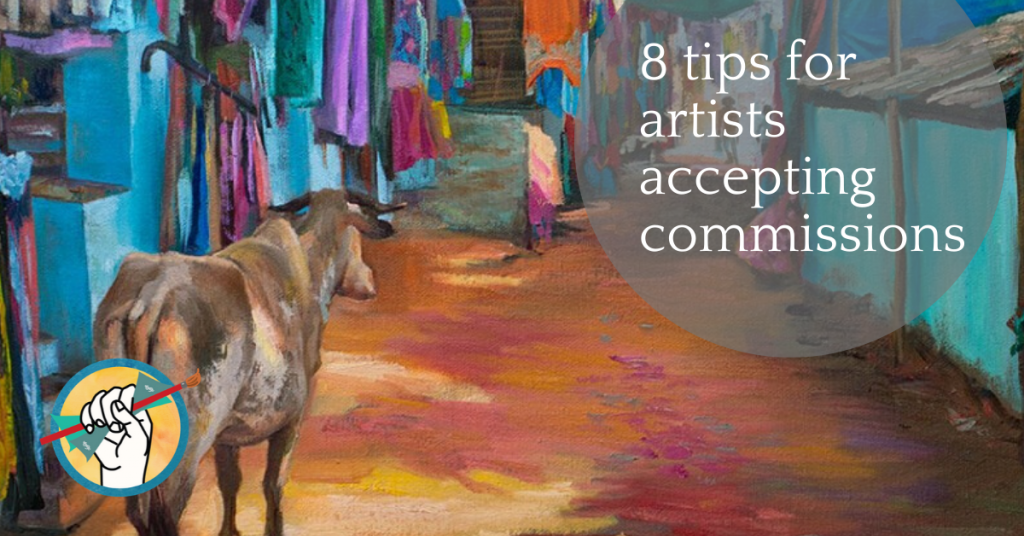As a self-employed artist, I rely on commissions more so than selling my work in galleries. However, some artists are not great negotiators or business-minded, and art commissions that start off optimistic can sometimes turn into a sour experience. These eight tips will help you maintain good clients, manage their expectations, and produce work with integrity.

1 – Timing is key. Be responsive and follow up on your leads immediately.
If someone expresses interest in buying one of your pieces, but can’t make a deposit or payment right away, take down their contact info and follow up with them by the end of the day/event. Most people who buy art don’t “need” it. It’s a luxury item that is often an impulse buy — they fall in love with the art and have to have it. But if you wait too long, the infatuation can fade or even transfer to another item. If the art is intended as a gift, timing is even more important. I learned while working in advertising that no matter how well your product is advertised, if you don’t make the sale at the right time, you’ve missed the chance. But luckily, people are more willing to wait when it comes to art.
2 – Don’t be shy to state your terms.
It’s always wise to have an artist’s agreement signed by both parties to protect you from unwarranted situations. First off, licensing terms should be made clear. Does the client want the right to reproduce the artwork for commercial use/sale? They may think that owning the artwork is the same as owning the license to reproduce it as they see fit. It’s your job to educate them if this is the case. Most artists retain their licensing rights for their work even after a sale. But an unaware client may take your commission and innocently reproduce it on T-shirts or publish it for commercial use without informing you first. That will definitely lead to a sticky situation that could be avoided. Freelance artists may also ask for a “kill fee” — a mandatory fee in case the project is cancelled midway. Kill fees can be 50 – 100% of the project cost, depending on how soon the project is cancelled.
3 – Ask for a payment up front.
It’s fair to ask for as much as 50% up front to cover the cost of your materials and time. Some people prefer 30% down and a couple of installments. I would recommend taking between 30 – 50% up front, unless the commission is for a friend or somebody who has good standing credit with you. For larger commissions, consider a monthly payment plan, where you send your client monthly progress updates. Making a payment will help both the patron and the artist stay invested in the piece, and build a credible professional relationship.
4 – Know exactly what you’re being asked to do.
Be clear in your descriptions and check in with the client at certain intervals. Remember why the client chose you to begin with, and don’t doubt your ability. DO take creative license — this is why you were hired! DO start with concepts or sketches for them to approve before moving on to costly or large scale work. DON’T check in too often, or seem unsure of yourself or ideas, as this is an open invitation for your patron to suggest their ideas, or perhaps drag you along a creative journey that isn’t your own. They’re just trying to help, but it’s probably doing the opposite.
5 – Cherish your good clients, and learn to manage difficult ones.
Not every commission will go smoothly, but don’t let a few bad experiences ruin the potential for great ones. I’ve had my share of difficult clients, especially when I was an eager and fresh art school graduate. This is a learning curve that will take experience, but here are some cues to watch out for. The good clients will insist on paying you up front, leave a lot of the artistic license to you, and give you a broad spectrum to work with without interfering with your creative process. Hang on to the good clients, as their trust will inspire you to be more creative, resulting in more portfolio pieces, and you’ll love what you do even more. The bad ones will try to dictate how you do things, change their minds after you’ve already started, or micromanage your work — but they insist they’re just trying to help. Good client management skills and educating your client on your process — like what you DO and DON’T need from them in terms of creative input — is crucial to keeping the integrity in your work.
6 – Know your market.
What type of art do you enjoy creating the most? What type of art are you best at? If you market yourself wisely, you’ll end up with commissions you absolutely enjoy. I had trouble deciding for a long time because I enjoy creating in many styles — my work ranges from plein air landscapes and travel memoirs to quirky dark illustrations to colourful portraits. If I had to choose, I do enjoy the illustrations the most, but they take the most time and have a much slimmer market compared to the landscapes and colourful portraits.
7 – Have a method to pricing your work.
This will prevent panic when an opportunity comes up. Most artists price their work based on a per project rate ($ = estimated hours to completion x hourly rate) or based on size ($/sq footage) but there are four variables to keep in mind:
1) Time – Will you be working weekends or long hours? Or can you do this leisurely in a couple of hours? Is it due immediately, or can you take your time?
2) Size – Larger pieces require more paint, materials, handling, shipping costs, etc.
3) Skill Required – Portraits and figurative art generally require more skill than landscapes, so they are priced higher. Is the subject complex, like lace or patterning that requires a lot of detail?
4) Creative Integrity – Will this piece enhance your portfolio, or will you never show it off after it’s complete? Is the project interesting, meaningful, and fun to work on?
8 – Provide a good experience by sharing your process.
The more open and honest you stay with a client, the more positive the experience will be for both parties. Check in periodically, and send them some photos of work in progress, or an enthusiastic update. I can’t stress the enthusiasm enough: YOU are the artist. If you sound excited about your piece, so will the client. If you sound unsure or unconfident, chances are your client will also lose confidence in the project.
Markham artist Stacey MacNevin stresses the importance of not just delivering a painting, but delivering an overall experience. She advises, “Spend the time up front really listening to what a client wants for their piece. They may say: ‘I love your stuff — do whatever you want’ but what they are really asking you for is an experience.” Commissioning an artist should be an interesting, thrilling, and enjoyable experience that is rich in conversation and creativity. So take the time to understand your client, listen to their vision, and give them some insight into your creative process. It’s worth the time two-fold: the client will feel more connected to the piece because they are now more connected to your process.
While art commissions can sometimes be an exercise in trial and error, in my experience, these tips make clients happy and allow you to maintain your artistic integrity and creative vision.
ABOUT THE ARTIST
 Fei Lu is a self-employed artist, creative director, and founder of Winged Canvas Art Hub in Markham, Ontario. Her paintings are known to be colourful and provocative with a touch of humor, hinting at a deeper story behind each painting. Her artwork has been published in Applied Arts and American Illustration and in private collections worldwide.
Fei Lu is a self-employed artist, creative director, and founder of Winged Canvas Art Hub in Markham, Ontario. Her paintings are known to be colourful and provocative with a touch of humor, hinting at a deeper story behind each painting. Her artwork has been published in Applied Arts and American Illustration and in private collections worldwide.

It’s great that you’ve mentioned how one can get more art commissioned or bought if they are able to market themselves wisely. My sister is interested in fine arts and would like to see if that hobby can be a good source of income for her. I’ll share this with her so that she’ll know more about the skills that she needs to develop or get in touch with an expert that can help her learn what she wants and needs to learn about the trade.
This was a great article. Thank you for the info and advice
Thanks for going over some tips for accepting commissions. I’m glad that you mentioned you should be check in with the client at certain levels to be sure you’re doing what you’re being asked to. This also seems important to make sure the artist and the client are on the same page throughout the process.
I like the comment about being sure to be enthusiastic when you are talking about your piece with the client. My sister wants to start commissioning artwork for her new home, but she is nervous about the investment. I am sure that if she finds artists that follow this guide then she should be just fine.
Great article! I’m so glad I found this site, and very much looking forward to what else I can learn from it! Thank you, Fei Lu for sharing!
Thank you great advice. I like the bit about providing an experience for the patron and keeping them involved in the process, creating a memorable experience will help ensure future recommendations too ?.
Love this article! Very helpful in breaking down requirements for doing art comissions.
Great post. Commissioned pieces are a great source of income for me as an artist. However you need to ensure you have a contract between yourself and the client in place and ensure you take a deposit.
Is the artist bound to refund the deposit if client dont like the painting?
Very insightful, thanks a lot for the article
Note to artists:
I don’t pay up front because I’ve had TWO artists rip me off– sent money and order, they said “ok cool” and that’s the last I ever ever heard from them. So many others have similar experiences.
Don’t be surprised or offended when people offer half up front, half upon sketch approval OR finished commission. It’s either that or you get on your fellow artists to stop ripping off clients and forcing them to go through the hassle of trying to get a refund.
Secondly: Communicate on a regular basis. Toss your client a brief update a few times a week just so they know you aren’t ghosting them and are reliable/working on the project. A message that takes you 30 seconds to email or type once or twice a week is going to get you repeat customers, promise on that. Artists who actually COMMUNICATE with their clients are so damned rare.
Third: If we give a deadline, and you take the job, you’d better hit that deadline or have a REAL good excuse why you didn’t. Same as any sort of contract/job. I’m an author; if I don’t hit my deadlines, my publisher is on my like flies on you-know-what. Being in a creative field is not an excuse to be late on work a client is paying for.
I know I sound a bit salty here, but after nearly losing several hundred dollars and having to go through the pain of a Paypal refund (and I’m not alone on this by any means), or having artists not bother to send updates for weeks at a time (if ever), or having artists continually saying “I know I was supposed to have it yesterday but…”, well, just ask yourself how you might feel in those situations after they’ve happened a few times.
Draw on.
Secondly:
Secondly?????????
Did the text box had limited words to put in? I want to hear more from your experience.
Unfortunately us artists also get ripped off and we’re apt to have that happen a lot more often since that is our job. I’m waiting for a £300 balance for a painting i completed and have a sneaky feeling i am not going to receive it. People don’t expect to order most other goods without upfront payment so why art?
When it comes to customers getting ripped off, there’s things you can do to ensure the integrity of the artist. Make sure they are actually an artist first off since most scammers are not and just steal other artists work to show people they intend to scam. genuine artists can show works in progress and photos of themselves with their art or working on it and maybe timelapse videos and that sort of thing. Secondly, make sure they have a website, long standing FB page and get references. If you can ask people you know for recommendation also. A genuine artist should have all of these as most work does come from word of mouth. No artist in their right ming starts a work without a down payment at the very least. If they do this, they are asking for trouble. I may have just got stung even though they paid a deposit but now thinking I am going to have to increase it. No chance would I start any work without upfront payment. Scamming goes both ways and arists often struggle enough as is and can be completely finished off by non payers.
Yep that is how not to do commissioned art, if you take a job on then do it. Artists like that give the rest of us a bad name. I would not be able to sleep if I took someone money, after all it is a compliment they reached out to you in the first place.
Updates are key for a good experience, if the buyer wanted just to see the final artwork they could have bought and not commissioned the artwork. Half of the fun is to see your personalised artwork being made.
I feel bad you went through that experience. There are alot of honest and professional hard seltzer I hope this does not turn you off commissioning art.
I’ve recently been given my first proper commission, I’m just terrified they don’t like it! What do you do then? I work very intuitively, I sometimes have a small starting point but I go where the ink takes me. I do have a consistent style but it still wide ranging. The clients have bought a print from me before and they want it along a similar vein but I still worry.
This is advice from our Head Coach Sarah: to some degree this is the hard part of doing a commission—will the clients like the piece. My best advice is do the very best work that you can and have a plan in mind in case the client doesn’t like it (fixing an area, redoing the piece, refunding their $$$$—the plan b depends on the clients and their reaction and what the artist is comfortable with). For future commissions, doing sketches and getting a 25-50% installment payment up front are good ways to put some buffers in place. Also be sure to have a contract that lays out revision processes et. (Crawford’s legal book for fine artists has great examples). Generally speaking, if someone loves your work so much that they are investing—especially if it’s more than once—they trust you and your artistic eye, so the work for the artist is to be confident in how they present the work for review. And that is often the hardest part—believing in ourselves.
Great tips, very helpful.
I will share it.
I found these tips.
1. Maintain Creative freedom through better communicating your ideas to clients
2. Maintain your CopyRights. Be aware of the term “Work for Hire” in your contracts.
3. Be Selective with the commission you take on. All commissions are not good commissions
Thanks Fei Lu!!!
Boy, was I naive. I thought if I commissioned it and paid for it, it was mine to do with as I wished, like a house. If I pay for a painting, I never want to see prints out there unless I say so. Thanks for the education.
Hi Huck,
Yes, the buyer buys the material property of the art piece, but not the intellectual property. Actually in theory artists can even decide to change something in the art work once it has been sold. This has happened with art bought by museums in France, but of course it is extreeeeemely rare 🙂
I love doing commissionend work, it is just so personal. Noting like seeing the face of the buyer when they see there ne pride and joy for the first time.
You must be honest and very open about the process, give the client the insideer experience. That is part of what they are buying.